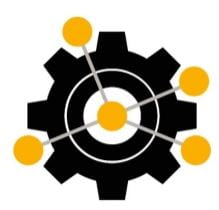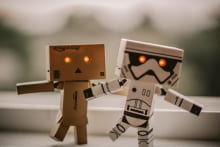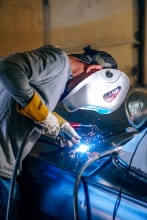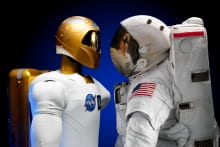Tag: workers and technology
Bruce Walker Interviewed for Inaugural ScienceMatters Podcast
Date: Wednesday, August 22, 2018
Bruce Walker, Professor of Psychology at Georgia Tech, and friend of the Work Science Center was recently interviewed for the inaugural ScienceMatters Podcast at GeorgiaTech. During this interview, he discusses data sonification and ways of making data and results easily accessible to the public
What is the Ideal Robot Teammate’s Personality?
By: Keaton Fletcher
What kind of robot would you want for a teammate? A recent theoretical paper argued that robot personality will influence individuals’ and teams’ motivation. To better understand robot personality, we must first briefly describe personality traits in humans. The most widely accepted model of human personality captures an individual’s general tendencies and preferences within five primary domains: extraversion (i.e., outgoingness and social dominance), neuroticism (i.e., emotional volatility, anxiety), agreeableness (i.e., politeness and preference for social harmony), conscientiousness (i.e., orderliness, detail-oriented, rule-abiding), and openness to experience (i.e., willingness to experience novel and ambiguous situations or stimuli). Generally speaking, we value high levels of extraversion, agreeableness, conscientiousness, and openness to experience, and low levels of neuroticism.
As robots become more advanced, humanoid, and ubiquitous, an understanding of robot personality in teams should help roboticists design and program the ideal robot teammate. Robert Jr. argued that, just like humans, a robot that appears to be high in all of the Big Five personality traits except for neuroticism, would help keep individuals and teams motivated. A study from 2006 found that simply being humanoid (as opposed to more mechanical) in shape, led to robots being perceived as higher in the Big Five (lower in neuroticism). If Robert Jr.’s theory is supported, this would suggest that when creating teams that incorporate robots, it is better to have a humanoid shaped robot than other designs, because this may help teams and individuals set more challenging goals, work harder and longer to achieve these goals, have a stronger belief that they can achieve these goals, which should ultimately improve performance and satisfaction. That said, as artificial intelligence capabilities increase, there may be ways to program the apparent personalities of robots to be more tailored to the situation, like what is seen in the 2014 movie Interstellar, or, less effectively, in the book series, Hitchhiker’s Guide to the Galaxy.
Automating Fashion

By: Xinyu Chu
Although automation and robotics has long impacted manufacturing jobs, with recent technological advances, even more traditional office jobs are feeling the change. A New York Times article by Noam Schieber discusses the role automation is playing in the fashion industry. For example, the tasks of a fashion buyer, which typically require intuition about changes in the tastes and preferences of customers in order to predict future fashion trends, are beginning to be supplemented, if not replaced, by artificial intelligence. Machine learning has enabled artificial intelligence algorithms to extract profile information about customers, ranging from the items they put in their wishlists to their search histories or occupations, to make better predictions about which items to stock and recommend. Traditionally fashion buyers work in large groups and each buyer focuses on a specific style of clothing, monitoring the possible changes in trends and customer preferences. With the aid of artificial intelligence, a small group of buyers, or even a sole individual, can handle the job.
Yet, use of artificial intelligence is not without its limitations. For many personalized fashion companies (e.g., StitchFix), although their algorithms can make better predictions of general trends and for each customer, they still require a human touch to collect the data and interact with customers. Many customers do not know exactly what they want, and, at least for now, it takes the expertise of a human consultant to help determine what sorts of input are most relevant for the algorithms. Left unchecked, artificial intelligence can create problems for organizations. For example, t-shirt company, Solid Gold Bomb, used an unchecked algorithm to create thousands of unique t-shirt designs based on the slogan “Keep Calm and Carry On,” replacing carry on with various phrases. Within these thousands of designs, a subset had a range of offensive phrases that no one from the company saw before uploading the options for purchase. Eventually, the company went bankrupt. A little more of a human touch in the process may have prevented these issues and saved the company.
Rather than completely eliminating employees from the workplace, the introduction of automation may simply change the way in which people work and the types of tasks they need to focus on.
Did You Google It? Enterprise Social Media Enhances Autonomous Learning
By: Keaton Fletcher
It has become expected by both employers and employees that jobs will require continued learning over the course of one’s career; enterprise social media is one method that companies can use to facilitate learning. According to a conference paper published by Carine Touré, Christine Michel, and Jean-Charles Marty, enterprise social media is essentially corporately sponsored online forums. These forums capitalize upon the current way most of us search for information outside of work (hint: we Google it).
Although there are many methods corporations can use to facilitate learning (e.g., formalized training programs, informal mentoring programs), evidence suggests that roughly 75% of learning at work occurs informally. Understanding this, organizations have tried different methods to ensure that employees have access to correct information when they need it. This started as knowledge management systems that functioned as repositories for knowledge. In theory, employees could search these knowledge repositories for the information they needed, when they needed it. However, oftentimes these static knowledge repositories are difficult to use or search, and are left unused, collecting digital or literal dust.
To address the weaknesses of these static knowledge management systems, organizations turned toward communities of practice. These communities introduced a social aspect to learning, allowed workers to share their experiences, learning from one another. In theory, communities of practice capitalize upon the social nature of humans, allowing the members to identify with their community, motivating them to participate. Touré and colleagues, however, suggest that these fall short of aspirations as well. Often, there are questions about the validity of information provided through communities of practice. Who determines who is eligible for the community, and how do they make this decision?
More recent attempts to address these issues rely on enterprise social media, to combine the benefits of traditional knowledge management systems and communities of practice. Online forums that connect workers within an organization, or across a discipline, allow for the creation of a large, and easily searchable knowledge repository. They also allow for social interaction through commenting and “liking” or “upvoting” answers or posts. This combination creates a dynamic and engaging way to create opportunities for informal learning on the job.
To test the design of an enterprise social media intervention, Touré and colleagues worked with a water treatment and distribution company in the south of France. The company originally had a traditional knowledge management system that acted as a catalog of information that was digitally accessible to employees. Employees reported not using this function to learn or to solve their problems. The researchers worked to implement an enterprise social media system for the company; they interviewed employees about how best to do this. Employees wanted comments to be moderated to prevent overuse or abuse, they wanted posts to be labeled with their level of information coverage and their level of utility. The researchers found that users thought the new system was easier to use, but that usage did not actually change because people still felt that they were already experts.
So, what have we learned? Combining digital repositories of knowledge with social media platforms offer companies ways to enhance informal learning. The next steps for companies may be helping employees recognize their own limitations, and the utility of seeking information from these systems.
Newsletter Issue No. 2
Reading the IT Leaves: NSF’s ITEST Program & the Future of Work
By: Keaton Fletcher
Technology is clearly changing the entire workforce, but how can workers change to keep up? To help this massive transition, The National Science Foundation sponsored ITEST (Innovative Technology Experiences for Students and Teachers). ITEST works to connect students from prekindergarten through 12th grade with professionals in STEM (science, technology, engineering, and math) careers to help students gain the necessary skills and knowledge for a successful career in the modern workforce.
To put the ITEST program into context, Malyn-Smith and colleagues (2017) published a paper reviewing the current workforce trends given the changes in technology. They argue that disruptive technologies and innovations are changing the status quo. Work will look fundamentally different in this new augmented age, when humans are enhanced by working with machines. To be successful, the modern worker, regardless of career path, industry sector, or job, must become knowledgeable about technology.
Malyn-Smith and colleagues point toward multiple technology-driven changes in the modern workforce to which workers will need to adapt. More and more frequently, workers will have to work in interdisciplinary teams of humans, but these teams will also include machine-based teammates as well. Given the technology-based increase in human capacity, workers will now be able to address problems that were beyond the realm of possibility ten years ago. However, these problems cannot be solved by solitary workers, or even teams of workers all with the same knowledge, skills, and abilities. Malyn-Smith and colleagues argue that the types of projects and problems that will become common in the modern workforce will require teams of individuals with unique skillsets and knowledge bases, all of whom will have to interact with machines in order to complete their tasks.
Workers will also have to become comfortable working with massive amounts of data. As machine learning, artificial intelligence, and automation become more common, the role and accessibility of data, especially big data sets, has become great. Modern workers will need, at the very least, to understand the role of data in problem-solving, how to present data, and also how to protect it.
Many organizations, Malyn-Smith and colleagues suggest, are already relying on informal learning in the workplace, and worker-initiated formal learning (e.g., certificate programs or higher education) during personal time to help address these changing demands. As the nature of work continues to change, the modern worker must be driven by personal interest to learn new skills. Malyn-Smith and colleagues argue that organizations may begin to care less about formal degrees or certifications, instead giving more value to evidence of specific skill sets that can be applicable across a variety of contexts.
Enter, ITEST. By exposing children to STEM careers from a young age, the NSF sponsored initiative seeks to not only normalize STEM careers, but also to help the next generation of workers begin thinking in ways that will be necessary in the modern workforce (e.g., data-driven). Since 2003, ITEST has sponsored over 300 projects, working with over 560,000 students and roughly 17,000 educators in the United States. Students learn scientific and technology-based content while being exposed to careers in STEM fields. Through this program, teachers are also given an opportunity to develop their own skill sets to better help prepare their students for the modern workforce. A multitude of scientific papers (e.g., Blustein et al, 2012; Christensen et al., 2014) have been published examining the efficacy of ITEST, all of which point toward its success.
Arguably the main takeaway of the NSF ITEST program and Malyn-Smith and colleagues’ paper is to promote early STEM learning, particularly in the face of the current changes in the workplace, so as to best prepare the next generation of workers for what lies ahead.
After Automation: Will There Be Enough Jobs?
By: Keaton Fletcher
Will your job be replaced by a robot? A report by McKinsey Global Institute suggests probably not.
Most people in the workforce today have, like those before them, wondered whether they will be replaced by new technology. The concern is so great, that Time Magazine released an article and an associated widget that tells you the odds of your job becoming automated. In a recent podcast, Peter Grumbel interviewed James Manyika, a Senior Partner at McKinsey & Company, about this very subject.
James Manyika suggests that previously, new technology, rather than replacing workers entirely often simply provided workers with additional support, or removed the need to complete mundane, routinized tasks. He suggests, however, that this may not necessarily be the case with the modern rise of machine learning and other methods of capitalizing on technology at work. Data suggest that computing power may have increased by roughly a 1 trillion-fold since 1956. The ability for modern computers, networks of computers, and cloud computing to rapidly complete complex calculations has added to the growing concern and excitement about what the next few years have in store for the modern workforce. Manyika suggests it is not just the computing power, but the accessibility of data. More than ever before, humans around the world are uploading unique data at unfathomable rates. For example, an estimate in 2012 suggested people upload about 250 million photos to Facebook per day. A similar report in 2014 estimated people upload about 1.8 billion photos per day across all social media platforms. The algorithms behind machine learning and artificial intelligence can use this surge in data points to help become more accurate.
Manyika argues that the unprecedented power and access to data will allow algorithms and AI to boost economic performance for companies and countries. But, what about workers? Based on their research, Manyika suggests that if your job consists primarily of data collection or processing, or if you are completing manual labor in a predictable and stable environment, your job will likely be automated. These three tasks prone to automation make up about 51% of economic activity. The good news, however, is that a mere 5% of occupations are primarily these tasks. A majority of jobs (60%) are a mixture of roughly 1/3 these tasks, 2/3 less easily automated tasks.
What does this mean for workers? Manyika suggests that most people will experience some major change in their jobs, but probably will not have to change occupations entirely. Future-oriented CEOs and organizations have already begun the process of training and developing their employees to be better able to adjust to the coming shifts in their workload and demands. Manyika also suggests that occupations in the care industry, or jobs that require empathy and judgment will be more common and more resistant to automation. By 2030, Manyika predicts about 16% of jobs, globally, will have been automated to some extent (this number rises in more industrialized countries), meaning that big change is coming for a large portion of the population.
So, are robots going to take your job? Probably not, but they will almost certainly change it.
Newsletter Issue No. 1
Science Fiction in Work: New Technologies in the Workplace
By: Keaton Fletcher
In a recent article, CNN highlighted seven ways in which technological advances are potentially changing the way we work. For example, humans are generally pretty terrible at cybersecurity. Many companies have started to use biometric authentication (e.g., iris scanning, fingerprint scanning, or facial recognition) to provide workers access to computer terminals. Hospitals have also started using this technology to protect medications and patient files. Some companies, such as Three Square Market, have started optional programs that allow employees to have a microchip embedded under their skin that acts as their ID badge.
Beyond simple technological innovations for cybersecurity, many companies are turning toward artificial intelligence (AI) to help workers perform better. In healthcare, for example, AI programs have been shown to complete a task that normally takes radiologists 45 minutes (determining blood flow and the volume of cardiac muscles) in a matter of seconds. But AI is not just limited to simple data processing. AI-CDß an AI robot used by McCann Worldgroup Japan, is used as a creative director for television ads.
AI has also made its way into the world of pop music, changing the careers of songwriters in addition to the soundscape on the radio. In a recent podcast episode, musicologist Nate Sloan of Fordham University, and songwriter Charlie Harding, interview songwriter Taryn Southern about her use of AI in songwriting. Together they discussed the multitude of AI programs available as tools to assist songwriters (e.g., Aiva, Flow Machines, Amper, and Nsynth) including the benefits and drawbacks. In a musical Turing Test, Nate and Taryn listened to six pairs of song clips: one written entirely by a human and the other written with the help of AI. The differences were hard to hear, with AI-based music often slightly more complex than human-only music. Both Taryn and Nate found themselves stumped more than once. The hosts acknowledged that in its current form, AI music is either a good tool in a songwriter’s belt or is a replacement for songwriters who are only writing stock music.
Another major area of technological advance is robotics. In a podcast episode, Pamela Gay, Director of Technology and Citizen Science for the Astronomical Society of the Pacific, and Fraser Cain, founder of The Universe Today and director of Cosmoquest, discussed the use of robots on the International Space Station. Specifically, they pointed out two semi-autonomous robots: Dextre and Robotonaut 2 (R2). Dextre is a large set of robotic arms that can either be controlled directly by astronauts or can run autonomously on pre-programmed tasks. It helps complete dangerous but relatively time-consuming and mundane repair activities on the outside of the space station. R2 is a humanoid robot that is being tested inside the ISS in its ability to take over routine, mundane tasks that require human-level dexterity.
Certainly, technological advances are making leaps and bounds. As we navigate the coming changes in the workplace, it will be critical to understand how humans interact with technology, and how technology changes the experience of work itself.







